lock VOLVO C70 2006 Owners Manual
[x] Cancel search | Manufacturer: VOLVO, Model Year: 2006, Model line: C70, Model: VOLVO C70 2006Pages: 182, PDF Size: 3.35 MB
Page 2 of 182
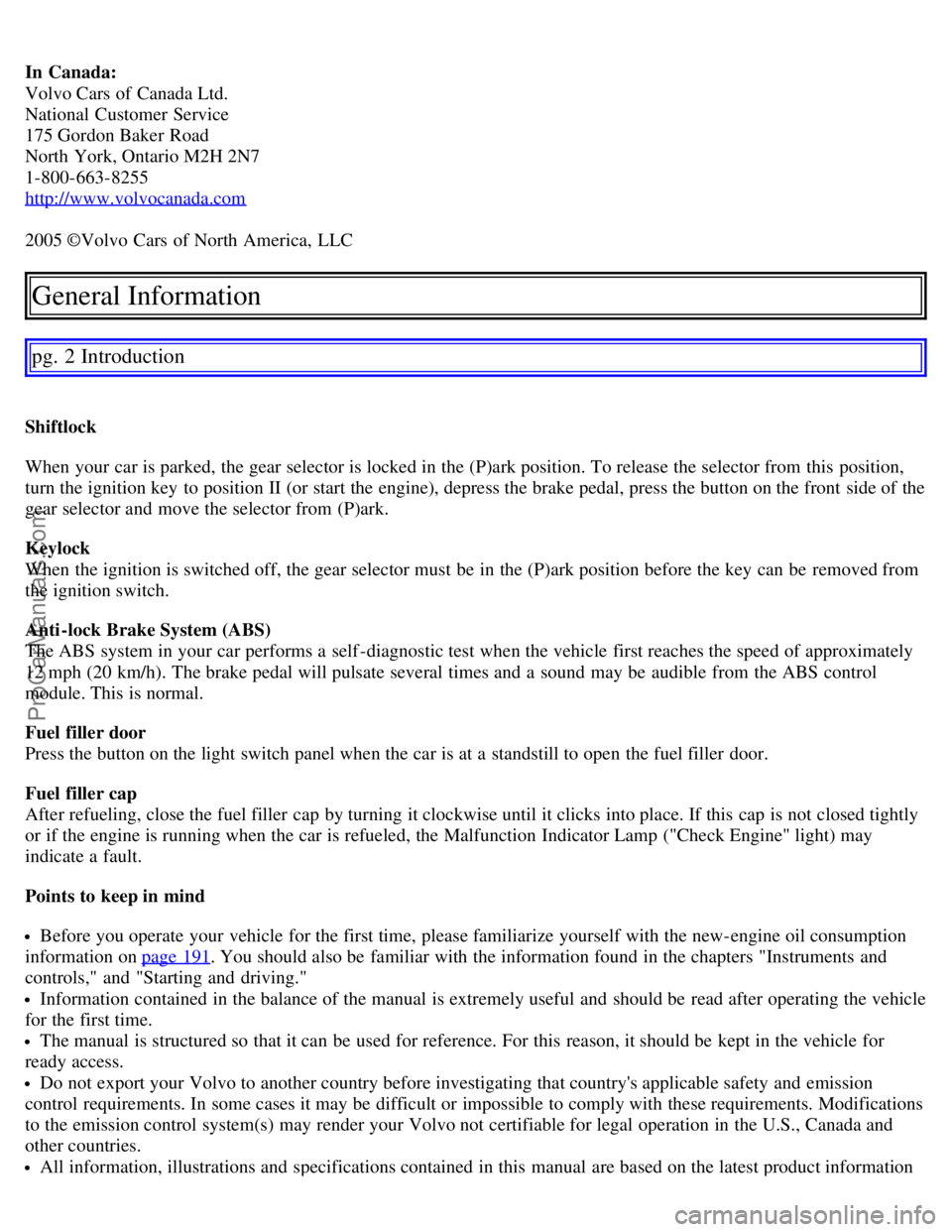
In Canada:
Volvo Cars of Canada Ltd.
National Customer Service
175 Gordon Baker Road
North York, Ontario M2H 2N7
1-800-663-8255
http://www.volvocanada.com
2005 ©Volvo Cars of North America, LLC
General Information
pg. 2 Introduction
Shiftlock
When your car is parked, the gear selector is locked in the (P)ark position. To release the selector from this position,
turn the ignition key to position II (or start the engine), depress the brake pedal, press the button on the front side of the
gear selector and move the selector from (P)ark.
Keylock
When the ignition is switched off, the gear selector must be in the (P)ark position before the key can be removed from
the ignition switch.
Anti-lock Brake System (ABS)
The ABS system in your car performs a self -diagnostic test when the vehicle first reaches the speed of approximately
12 mph (20 km/h). The brake pedal will pulsate several times and a sound may be audible from the ABS control
module. This is normal.
Fuel filler door
Press the button on the light switch panel when the car is at a standstill to open the fuel filler door.
Fuel filler cap
After refueling, close the fuel filler cap by turning it clockwise until it clicks into place. If this cap is not closed tightly
or if the engine is running when the car is refueled, the Malfunction Indicator Lamp ("Check Engine" light) may
indicate a fault.
Points to keep in mind
Before you operate your vehicle for the first time, please familiarize yourself with the new-engine oil consumption
information on page 191
. You should also be familiar with the information found in the chapters "Instruments and
controls," and "Starting and driving."
Information contained in the balance of the manual is extremely useful and should be read after operating the vehicle
for the first time.
The manual is structured so that it can be used for reference. For this reason, it should be kept in the vehicle for
ready access.
Do not export your Volvo to another country before investigating that country's applicable safety and emission
control requirements. In some cases it may be difficult or impossible to comply with these requirements. Modifications
to the emission control system(s) may render your Volvo not certifiable for legal operation in the U.S., Canada and
other countries.
All information, illustrations and specifications contained in this manual are based on the latest product information
ProCarManuals.com
Page 5 of 182
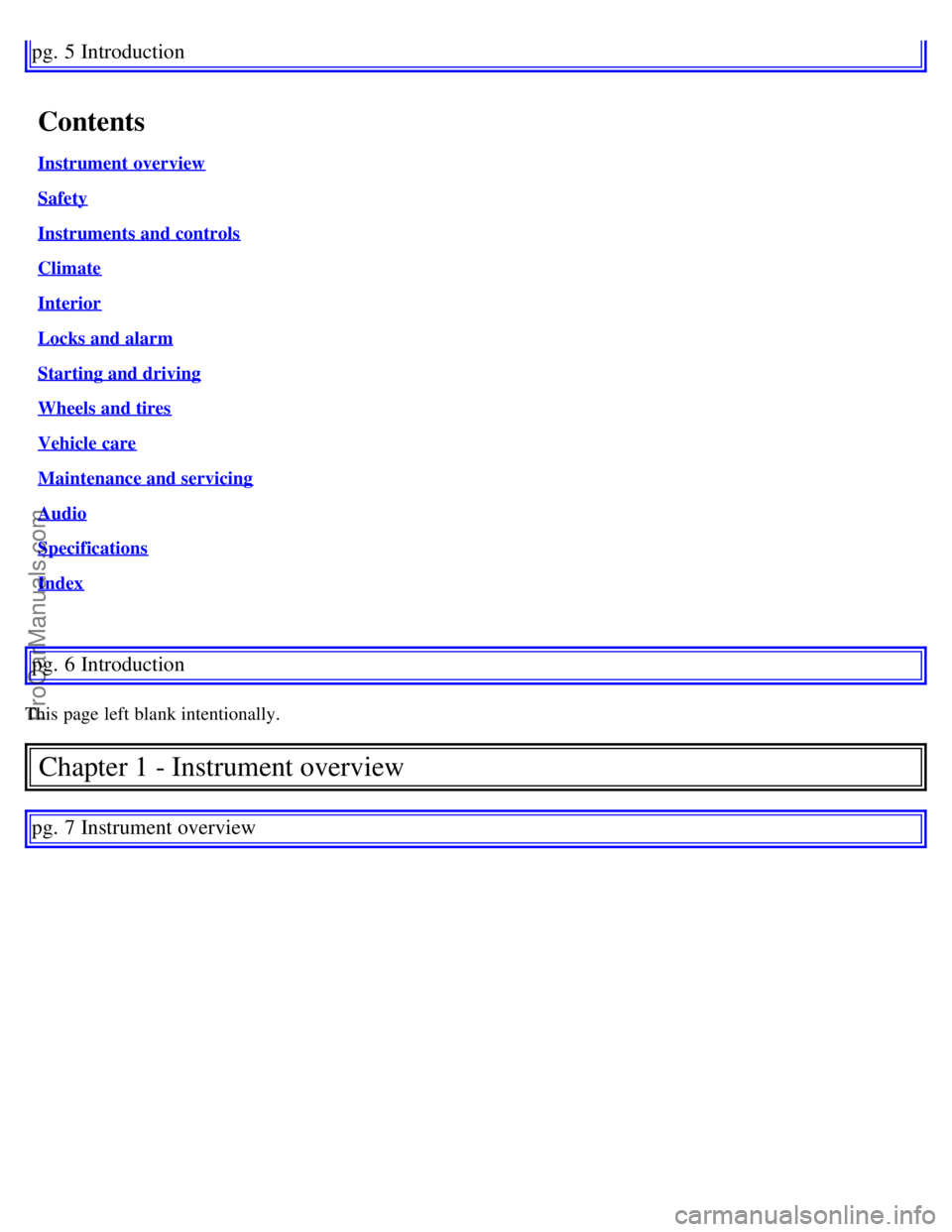
pg. 5 Introduction
Contents
Instrument overview
Safety
Instruments and controls
Climate
Interior
Locks and alarm
Starting and driving
Wheels and tires
Vehicle care
Maintenance and servicing
Audio
Specifications
Index
pg. 6 Introduction
This page left blank intentionally.
Chapter 1 - Instrument overview
pg. 7 Instrument overview
ProCarManuals.com
Page 6 of 182
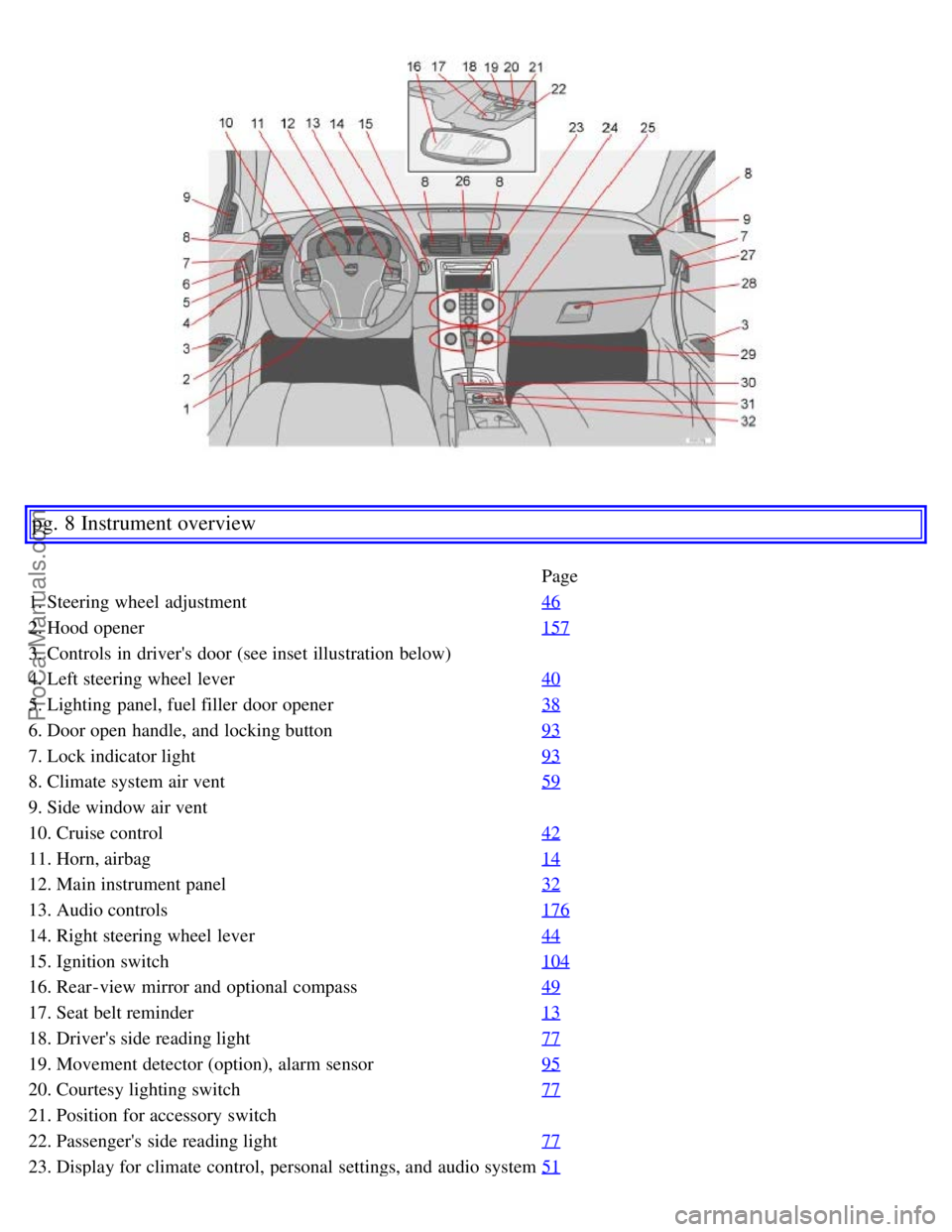
pg. 8 Instrument overview
Page
1. Steering wheel adjustment 46
2. Hood opener157
3. Controls in driver's door (see inset illustration below)
4. Left steering wheel lever40
5. Lighting panel, fuel filler door opener38
6. Door open handle, and locking button93
7. Lock indicator light93
8. Climate system air vent59
9. Side window air vent
10. Cruise control42
11. Horn, airbag14
12. Main instrument panel32
13. Audio controls176
14. Right steering wheel lever44
15. Ignition switch104
16. Rear-view mirror and optional compass49
17. Seat belt reminder13
18. Driver's side reading light77
19. Movement detector (option), alarm sensor95
20. Courtesy lighting switch77
21. Position for accessory switch
22. Passenger's side reading light77
23. Display for climate control, personal settings, and audio system51
ProCarManuals.com
Page 7 of 182
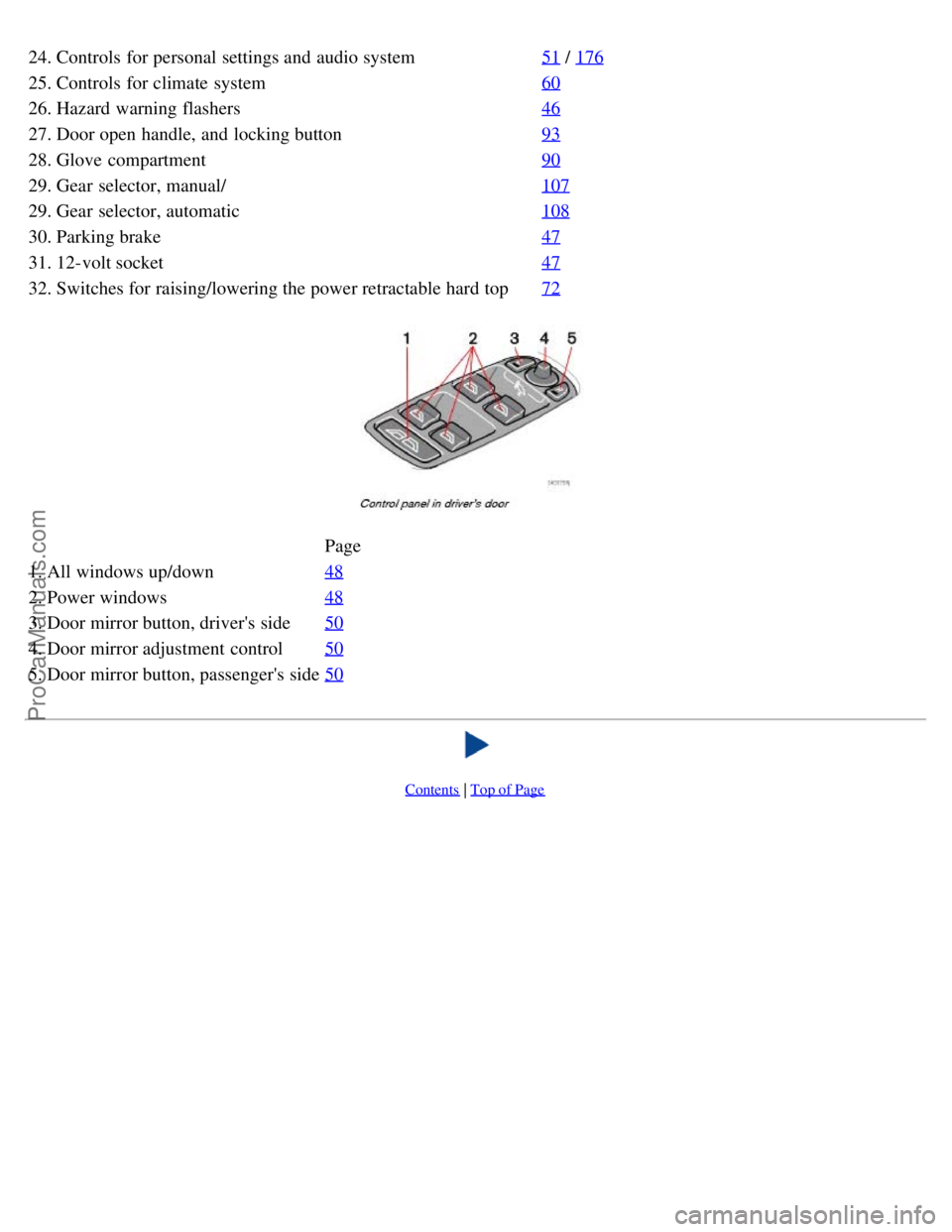
24. Controls for personal settings and audio system51 / 176
25. Controls for climate system60
26. Hazard warning flashers46
27. Door open handle, and locking button93
28. Glove compartment90
29. Gear selector, manual/107
29. Gear selector, automatic108
30. Parking brake47
31. 12-volt socket47
32. Switches for raising/lowering the power retractable hard top72
Page
1. All windows up/down 48
2. Power windows48
3. Door mirror button, driver's side50
4. Door mirror adjustment control50
5. Door mirror button, passenger's side50
Contents | Top of Page
ProCarManuals.com
Page 10 of 182

Buckling a seat belt
Pull the belt out far enough to insert the latch plate into the receptacle until a distinct click is heard. The seat belt
retractor is normally "unlocked" and you can move freely, provided that the shoulder belt is not pulled out too far. The
retractor will lock up as follows:
if the belt is pulled out rapidly
during braking and acceleration
if the vehicle is leaning excessively
when driving in turns
When wearing the seat belt remember:
The belt should not be twisted or turned.
The lap section of the belt must be positioned low on the hips (not pressing against the abdomen).
Make sure that the shoulder belt is rolled up into its retractor and that the shoulder and lap belts are taut.
Unbuckling the seat belt
To remove the seat belt, press the red section on the seat belt receptacle. Before exiting the vehicle, check that the
seat belt retracts fully after being unbuckled. If necessary, guide the belt back into the retractor slot.
WARNING!
Never use a seat belt for more than one occupant. Never wear the shoulder portion of the belt under the arm, behind
the back or otherwise out of position. Such use could cause injury in the event of an accident. As seat belts lose
much of their strength when exposed to violent stretching, they should be replaced after any collision, even if they
appear to be undamaged.
pg. 12 Safety
Seat belts
WARNING!
Never repair the belt yourself; have this work done by a trained and qualified Volvo service technician only.
Any device used to induce slack into the shoulder belt portion of the three-point belt system will have a
detrimental effect on the amount of protection available to you in the event of a collision.
ProCarManuals.com
Page 13 of 182

Never try to repair any component or part of the SRS yourself. Any interference in the system could cause
malfunction and serious injury. All work on these systems should be performed by a trained and qualified Volvo
service technician.
WARNING!
If your vehicle has been subjected to flood conditions (e.g. soaked carpeting/ standing water on the floor of the
vehicle) or if your vehicle has become flood-damaged in any way, do not attempt to start the vehicle or put the key
in the ignition before disconnecting the battery (see below). This may cause airbag deployment which could result in
personal injury. Have the vehicle towed to a trained and qualified Volvo service technician for repairs.
Automatic transmission:
Before attempting to tow the vehicle, use the following procedure to override the shiftlock system to move the gear
selector to the neutral position:
Switch off the ignition for at least 10 minutes and disconnect the battery
Wait at least one minute.
Insert the key in the ignition and turn it to position II.
Press firmly on the brake pedal.
Move the gear selector from (P)ark to the (N)eutral position. See page 110 for information on manually overriding
the shiftlock system.
pg. 15 Safety
Front airbags
The front airbag system
The front airbags supplement the three-point seat belts. For these airbags to provide the protection intended, seat belts
must be worn at all times.
The front airbag system includes gas generators (1) surrounded by the airbags (2) and a deceleration sensor (3) that
activates the gas generators, causing the airbags to be inflated with nitrogen gas.
ProCarManuals.com
Page 25 of 182

Attempting to start the car
If damage to the car is minor and there is no fuel leakage, you may attempt to start the car. To do so:
Remove the ignition key.
Reinsert the key in the ignition switch. The car will then attempt to reset COLLISION STATUS to normal status.
Try to start the car.
Moving the car
If the electrical system is able to reset system status to normal (CRASH STATUS SEE MANUAL will no longer be
shown in the display), the car may be moved carefully from its present position, if for example, it is blocking traffic. It
should, however, not be moved farther than is absolutely necessary.
WARNING!
Even if the car appears to be drivable after COLLISION STATUS has been set, it should not be driven or towed
(pulled by another vehicle). There may be concealed damage that could make it difficult or impossible to control.
The car should be transported on a flatbed tow truck to a trained and qualified Volvo service technician for
inspection/repairs.
pg. 27 Safety
Inspecting SRS system components
Inspection date
1. Driver's side airbag
2. Passenger's side airbag
3. Side airbag on the driver's side
4. Side airbag on the passenger's side
5. Driver's side inflatable curtain
6. Passenger's side inflatable curtain
WARNING!
There is no owner maintenance that can be performed on the SRS system. The month and year shown on the decal to
the right (located on door pillar) indicate when you should contact your Volvo retailer for specific servicing or
replacement of airbag system components. This service must be performed by a trained and qualified Volvo service
technician.
ProCarManuals.com
Page 27 of 182
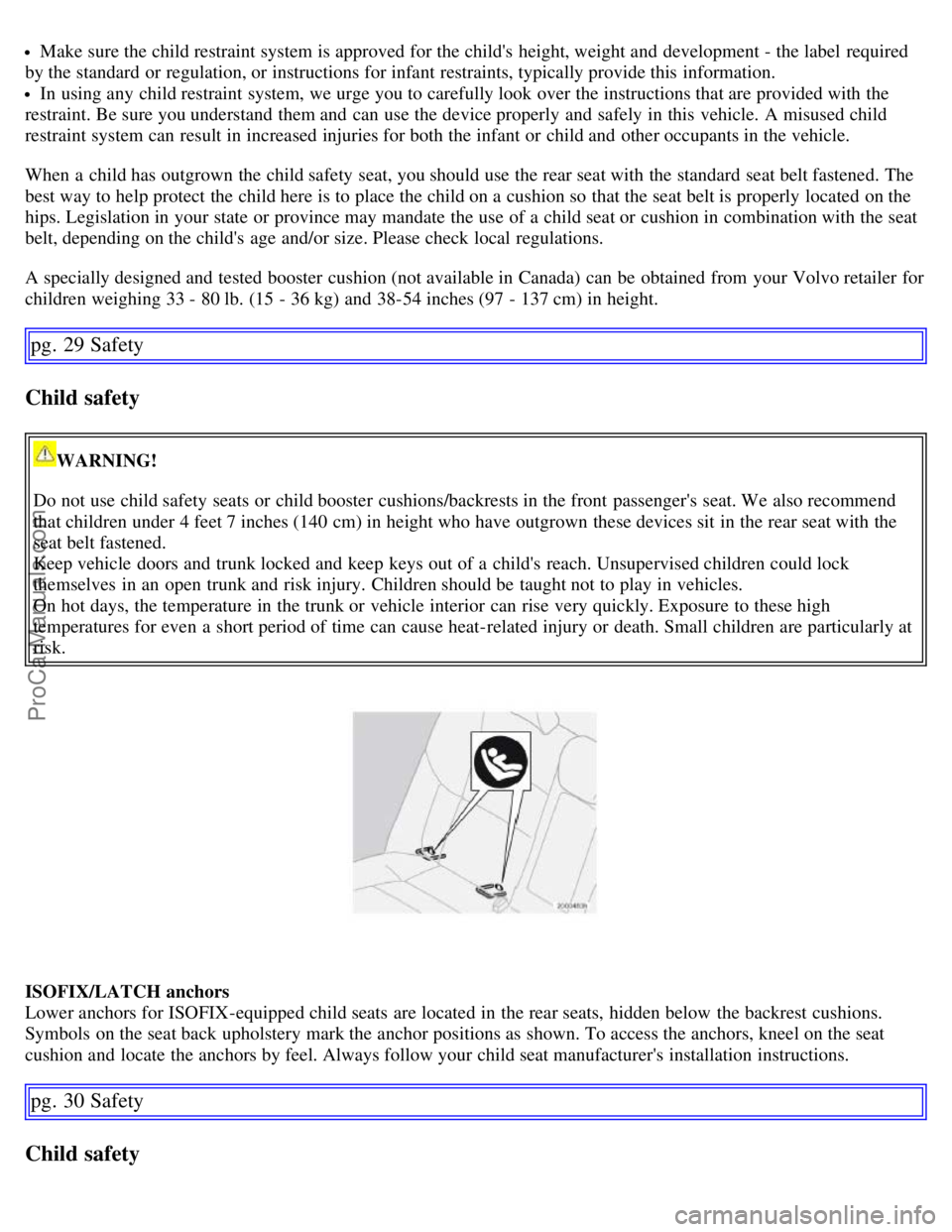
Make sure the child restraint system is approved for the child's height, weight and development - the label required
by the standard or regulation, or instructions for infant restraints, typically provide this information.
In using any child restraint system, we urge you to carefully look over the instructions that are provided with the
restraint. Be sure you understand them and can use the device properly and safely in this vehicle. A misused child
restraint system can result in increased injuries for both the infant or child and other occupants in the vehicle.
When a child has outgrown the child safety seat, you should use the rear seat with the standard seat belt fastened. The
best way to help protect the child here is to place the child on a cushion so that the seat belt is properly located on the
hips. Legislation in your state or province may mandate the use of a child seat or cushion in combination with the seat
belt, depending on the child's age and/or size. Please check local regulations.
A specially designed and tested booster cushion (not available in Canada) can be obtained from your Volvo retailer for
children weighing 33 - 80 lb. (15 - 36 kg) and 38-54 inches (97 - 137 cm) in height.
pg. 29 Safety
Child safety
WARNING!
Do not use child safety seats or child booster cushions/backrests in the front passenger's seat. We also recommend
that children under 4 feet 7 inches (140 cm) in height who have outgrown these devices sit in the rear seat with the
seat belt fastened.
Keep vehicle doors and trunk locked and keep keys out of a child's reach. Unsupervised children could lock
themselves in an open trunk and risk injury. Children should be taught not to play in vehicles.
On hot days, the temperature in the trunk or vehicle interior can rise very quickly. Exposure to these high
temperatures for even a short period of time can cause heat-related injury or death. Small children are particularly at
risk.
ISOFIX/LATCH anchors
Lower anchors for ISOFIX-equipped child seats are located in the rear seats, hidden below the backrest cushions.
Symbols on the seat back upholstery mark the anchor positions as shown. To access the anchors, kneel on the seat
cushion and locate the anchors by feel. Always follow your child seat manufacturer's installation instructions.
pg. 30 Safety
Child safety
ProCarManuals.com
Page 28 of 182
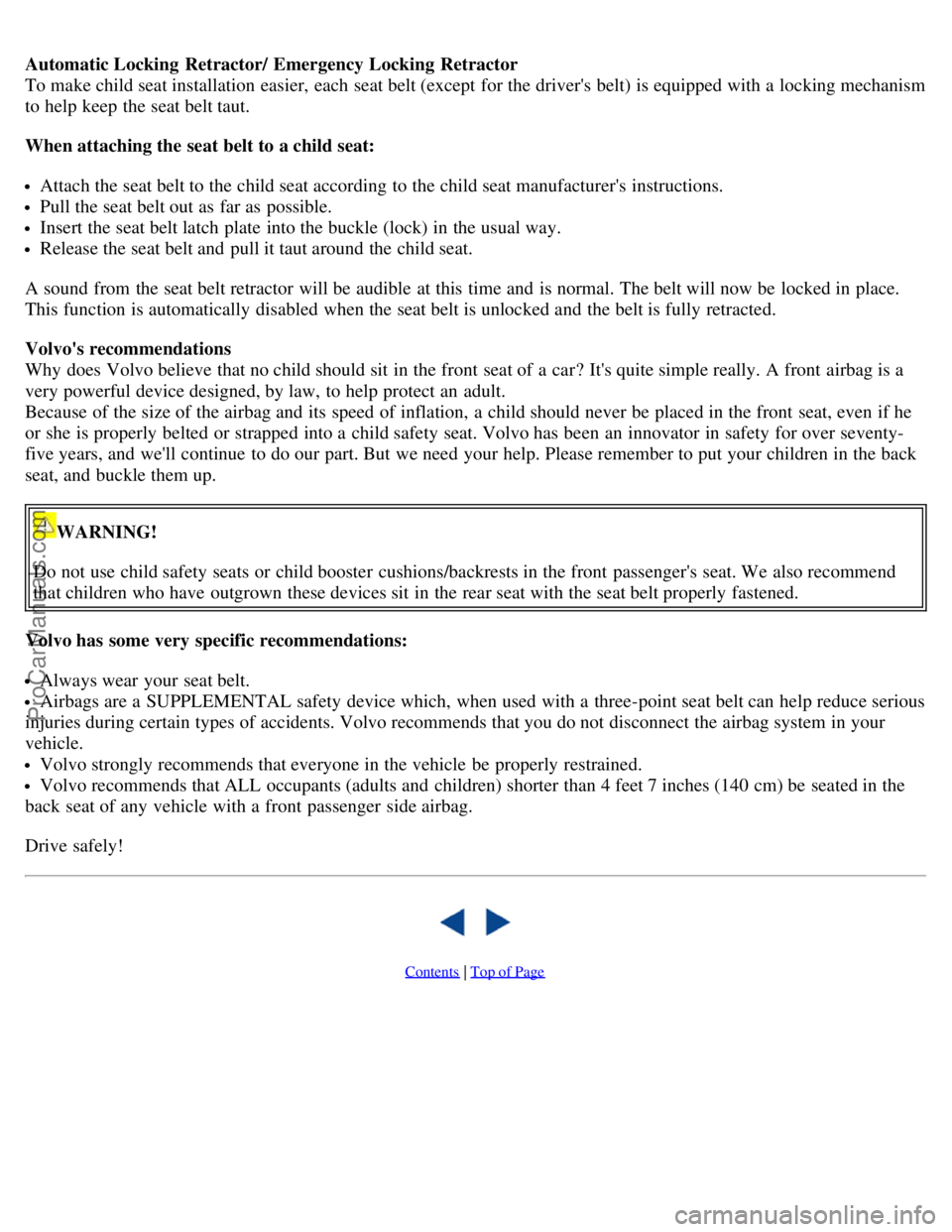
Automatic Locking Retractor/ Emergency Locking Retractor
To make child seat installation easier, each seat belt (except for the driver's belt) is equipped with a locking mechanism
to help keep the seat belt taut.
When attaching the seat belt to a child seat:
Attach the seat belt to the child seat according to the child seat manufacturer's instructions.
Pull the seat belt out as far as possible.
Insert the seat belt latch plate into the buckle (lock) in the usual way.
Release the seat belt and pull it taut around the child seat.
A sound from the seat belt retractor will be audible at this time and is normal. The belt will now be locked in place.
This function is automatically disabled when the seat belt is unlocked and the belt is fully retracted.
Volvo's recommendations
Why does Volvo believe that no child should sit in the front seat of a car? It's quite simple really. A front airbag is a
very powerful device designed, by law, to help protect an adult.
Because of the size of the airbag and its speed of inflation, a child should never be placed in the front seat, even if he
or she is properly belted or strapped into a child safety seat. Volvo has been an innovator in safety for over seventy-
five years, and we'll continue to do our part. But we need your help. Please remember to put your children in the back
seat, and buckle them up.
WARNING!
Do not use child safety seats or child booster cushions/backrests in the front passenger's seat. We also recommend
that children who have outgrown these devices sit in the rear seat with the seat belt properly fastened.
Volvo has some very specific recommendations:
Always wear your seat belt.
Airbags are a SUPPLEMENTAL safety device which, when used with a three-point seat belt can help reduce serious
injuries during certain types of accidents. Volvo recommends that you do not disconnect the airbag system in your
vehicle.
Volvo strongly recommends that everyone in the vehicle be properly restrained.
Volvo recommends that ALL occupants (adults and children) shorter than 4 feet 7 inches (140 cm) be seated in the
back seat of any vehicle with a front passenger side airbag.
Drive safely!
Contents | Top of Page
ProCarManuals.com
Page 29 of 182

2 0 0 6
VOLVO C70
Chapter 3 - Instruments and controls
pg. 31 Instruments and controls
Instrument panel 32
Indicator and warning symbols33
Symbols on the left side of the instrument panel34
Symbols on the right side of the instrument panel35
Symbols on the center of the instrument panel36
Information display37
Lighting panel38
Manually unlocking the fuel filler door39
Left-side steering wheel lever40
Trip computer41
Cruise control42
Right-side steering wheel lever44
Rain sensor45
Steering wheel adjustment, Hazard warning flashers46
Parking brake, 12 volt sockets47
Power windows48
Mirrors49
Personal settings51
Home Link® Universal Transceiver (option)53
pg. 32 Instruments and controls
Instrument panel
ProCarManuals.com